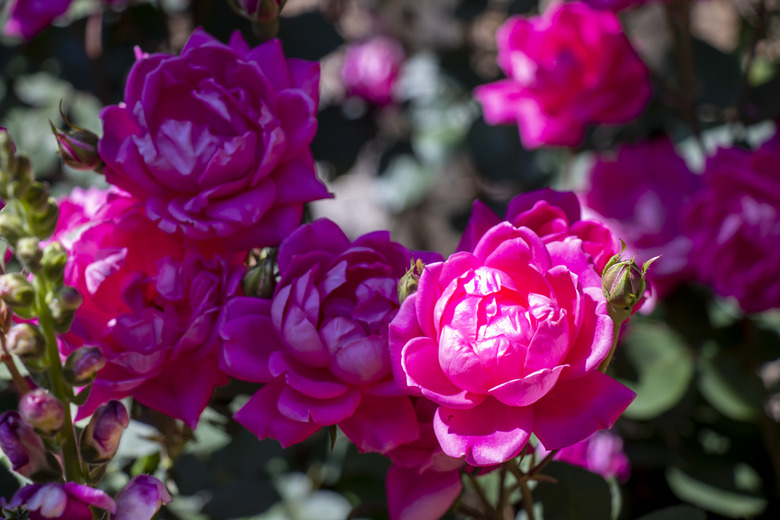Knock Out Rose Maintenance
If you've been avoiding growing roses (Rosa spp.) because of their fussy nature, then you haven't met the Knock Out. With their ease of growth, minimal care requirements and resistance to disease, it's easy to see why these beauties are so popular. Their minimal maintenance requirements make them the perfect garden addition for lazy gardeners or those who have failed at growing roses before.
Knock Out Noteworthy Characteristics
Created by the Conrad-Pyle Company and introduced to the market in 2000, the original Knock Out rose was Rosa 'Radrazz,' with cherry-red or hot-pink single flowers. Now, there are multiple selections, from the double pink Rosa 'Radtkopink' to the double coral Rosa 'Radral' to the newest addition, Rosa 'Meibenbino,' which is the first miniature Knock Out sporting fire-engine red blooms. All Knock Out roses other than the miniature are hardy in U.S. Department of Agriculture plant hardiness zones 5 through 11. 'Meibenbino' is only hardy to zone 10.
Most Knock Out roses have a bushy form, growing up to 4 feet tall with about the same width. However, miniatures top out around 18 inches tall. Depending on the cultivar, the evergreen, serrated foliage is glossy to dull and green to having hints of blue or purple. The plants bloom almost year-round with single or double lightly fragrant flowers. Colors include white, red, pink and coral with hints of yellow in some cultivars.
Preferred Conditions and Irrigation
The first step in promoting healthy growth leading to a low-maintenance shrub is planting the rose in its preferred conditions. Fortunately, Knock Out roses aren't plagued by most diseases or pests, so you can knock that off the maintenance list. Consider the rose's mature size and select a site where it has room to grow and receives good air circulation. You'll want a site that gets six to eight hours of daily sun with well-draining soil that has a pH between 6.0 and 6.5. Avoid putting undue stress on the rose by not planting it any deeper than it was growing in its original pot.
Irrigate after planting and water several times weekly for the first month or so while it establishes itself. Although relatively drought-tolerant once established, the rose will appreciate regular water applications while blooming and when conditions are hot and dry. Adding several inches of an organic mulch over the planting site helps reduce weeds and helps the soil retain moisture. Just keep the mulch pulled back several inches from the rose's base.
Knock Out Fertilization and Pruning
Knock Out roses aren't big feeders and grow well without additional fertilizer. However, if you wish to fertilize yours because a soil test indicates depleted soil nutrients, make sure the plant establishes itself on the site and experiences at least one cycle of flowering first. Use a general-purpose blend specific to roses and apply according to product instructions. Moisten the soil before applying. After applying, water the product into the soil. If any of the fertilizer gets on the foliage, be sure to rinse it off to prevent burning.
The rose doesn't require deadheading, as all types are self-cleaning. You can trim off dead or crossing branches throughout the year and do any shaping during the growing season. In late winter to early spring, trim the rose bush down to about 12 inches, which leads to a fuller shrub. Always sterilize your pruning tools by dipping the blades in rubbing alcohol so you don't accidentally transfer a disease to the plant.
